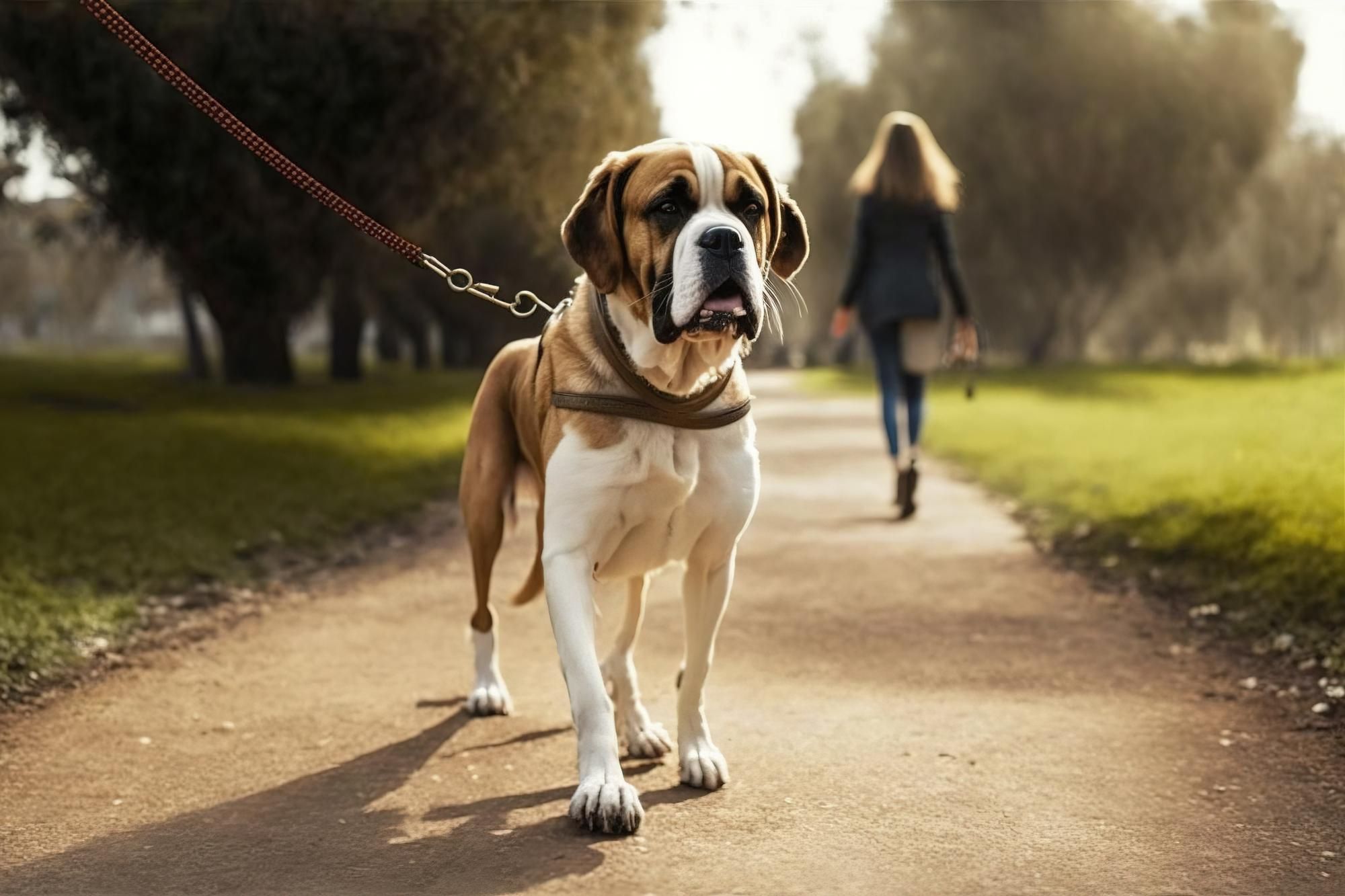As dog owners, we want to ensure that our furry companions are healthy and happy. One crucial aspect of their well-being is ensuring they get enough exercise through daily walks. However, heat can pose a significant risk to dogs' health and safety during the summer. Therefore, it's essential to understand the temperature limits for taking our pets on walks.

Understanding how dogs regulate their body temperature is crucial in determining when it's too hot to walk. Unlike humans, dogs do not sweat as efficiently, making them more susceptible to overheating. Factors such as breed, age, and underlying health conditions can also affect a dog's ability to tolerate heat.
This article will delve into these factors and provide tips on accurately measuring outdoor temperatures while discussing safe temperature ranges for dog walks. We will also examine strategies for adapting walk schedules and locations during hot weather, as well as protective gear options available for dogs during heat waves.
Understanding Dog's Body Temperature Regulation

Understanding how dogs regulate their body temperature and the differences between human and canine heat tolerance is crucial in determining when it is safe to take them for walks in hot weather. Prioritizing their well-being over personal interests is essential. Here are some tips for walking your dog in hot temperatures.
Dogs cannot sweat like humans do, so hot weather limits their ability to cool down. Instead, they pant heavily and release heat through their paw pads, allowing them to maintain a steady internal temperature despite rising air temperatures.
However, not all breeds can regulate their body temperatures equally. Some breeds with thick fur coats, such as Huskies or Malamutes, are more comfortable in colder climates, while short-haired breeds like Whippets or Greyhounds are better suited for warmer climates and weather.
Additionally, senior dogs or those with underlying health conditions may be more susceptible to heatstroke, which occurs when the dog's internal temperature rises above its normal range.
To ensure your dog's safety, monitor their behavior closely during walks in hot weather and avoid taking them out during the peak temperatures of the day. Opt for early morning walks when it's cooler.
It's important to keep your dog safe by checking the ground temperature before taking them outside. Use the back of your hand to test if the ground is too hot or if it can potentially burn your dog's paws.
Here are some tips on walking your dog in such conditions to give them the best possible care and ensure their well-being.
The Impact of Excessive Heat on Dogs

Excessive heat can have severe consequences for dogs, so it's important to know the risks associated with hot weather. One of the most serious risks is heatstroke, which occurs when a dog's body temperature rises above its normal range and cannot regulate itself effectively.
Heatstroke can happen if a dog is exposed to high temperatures for an extended period or engages in strenuous activity during hot weather, even if the temperature is high. Common symptoms of heatstroke include excessive panting, drooling, vomiting, diarrhea, and lethargy. In severe cases, it can lead to seizures or even death.
Walking dogs on hot pavement also poses a risk of paw pad burns. Dogs' paw pads are sensitive and can easily become damaged from exposure to hot surfaces like concrete or asphalt. These burns can be painful for the animal and may require medical attention to heal properly.
To prevent these issues, pet owners should modify their walks and avoid walking their dogs during the hottest parts of the day. It's best to stick to shaded areas or grass and soil whenever possible. Additionally, it's essential to test the pavement surface by placing the back of your hand on it for several seconds before allowing your dog to walk on it, ensuring it's not too hot for their paws. This is known as the "five-second rule."
Morning and late evening are often safer times to walk as the temperature tends to drop. It is generally safe to walk a dog when the temperature is below 70 degrees. Remember to have a collapsible water bowl and provide cool water for your dog during the walks.
Keep in mind that different sizes and breeds of dogs may have different care needs. These guidelines can help, but it's always best to monitor your pet and their comfort levels while walking.
What Temperature Should Dogs Not Walk At?

Walking dogs in temperatures above 85 degrees Fahrenheit can lead to paw pad burns, as pavement temperatures during the hottest parts of the day can reach up to 143 degrees Fahrenheit, according to a study. As a responsible dog owner, it's important to be aware of when it's too hot to walk your dog and take steps to avoid putting them in danger.
Signs that your dog may be overheated include excessive panting, drooling, lethargy, and vomiting. In addition to monitoring your dog for signs of heat exhaustion or heatstroke, paying attention to the temperature and humidity levels before taking them on a walk is essential.
A good rule of thumb is that if the temperature is too hot for you to comfortably stand outside without feeling uncomfortable or dehydrated, it's too hot for your dog. When walking dogs in hot weather, consider going out early in the morning or late at night when temperatures are lower, and avoid walking on pavement or other surfaces that can become dangerously hot.
By being proactive about keeping your furry friend safe during hot weather conditions, you can ensure many happy walks together for years to come.
How to Measure Outdoor Temperature Appropriately
Measuring outdoor temperature can be tricky as air temperature may not always accurately reflect ground temperature. Here are three important things to keep in mind when trying to gauge whether it's too hot for dog walks:
- Consider the humidity level: Humidity plays a crucial role in how hot it feels outside. When the air is humid, sweat does not evaporate from our skin as efficiently, making us feel hotter and more uncomfortable. Similarly, dogs also struggle with high humidity levels.
- Check the ground temperature: While air temperature gives you a general idea of how hot it is outside, the ground temperature can be significantly higher than the surrounding air due to heat absorption and retention by concrete or asphalt surfaces. If the pavement is too hot for your bare feet, then it's too hot for your furry friend's paws.
- Use the Five-Second Rule: The five-second rule involves placing your hand on the pavement or grass for five seconds and checking if it feels uncomfortably hot or not. If it does, then avoid walking your dog during the peak hours of sunlight and opt for early morning or late evening walks instead.
By considering these factors and using techniques such as the Five-Second Rule to accurately gauge temperatures before dog walks, we can help ensure our furry friends remain safe and comfortable during their outdoor adventures, even during extreme heat conditions.
Determining the Safe Temperature Range for Dog Walks
When considering the safety of outdoor activities for dogs, it's important to take various factors into account that can affect their health and well-being. One crucial factor is temperature, as dogs are vulnerable to heat-related illnesses such as dehydration, heat stroke, and paw burns. Therefore, it's crucial to determine a safe temperature range for dog walks based on their breed, age, and health condition.
Generally, a safe temperature range for dog walks falls between 60°F (15°C) and 75°F (24°C), but this can vary depending on the individual characteristics of each dog. For example, breeds like Huskies and Malamutes are better suited for colder temperatures due to their thick coats, while breeds like Bulldogs and Pugs are more sensitive to heat due to their short noses, which can make breathing more difficult. Additionally, older dogs or those with pre-existing health conditions may have a lower tolerance for hot weather compared to younger or healthier dogs.
Pet owners need to be aware of these differences in order to prevent potential harm to their furry friends when taking them out for a walk on hot days. By considering their specific breed, age, and health condition, and adhering to a safe temperature range, we can ensure the well-being and safety of our beloved pets during outdoor activities.
Adapting Walk Schedules and Locations During Hot Weather
During periods of hot weather, pet owners need to modify their dog's walking schedules and locations to ensure their safety and well-being. This can be achieved through various strategies, such as adapting walk schedules and locations during peak heat periods.
Pet owners should avoid taking their dogs out for walks during the hottest part of the day, typically between 10 am and 4 pm. Instead, they can opt for early morning or late evening walks when the temperature is cooler.
Another strategy that pet owners can adopt is finding cool and shaded walking locations for their dogs. These alternatives provide a comfortable environment while ensuring that their pets get enough exercise. Some suggested locations include parks with plenty of trees or grassy areas that are not exposed to direct sunlight.
Additionally, pet owners should always bring water along on walks to keep their dogs hydrated. By modifying walk times and locations during hot weather and providing essential exercise opportunities, pet owners can ensure their dog's safety and well-being.
Preventing and Responding to Overheating During Walks
Protecting dogs' safety during outdoor walks in hot weather requires pet owners to be aware of the signs of overheating and take necessary precautions, such as providing hydration and rest.
Dogs are susceptible to heatstroke when exposed to high temperatures, especially during walks. As responsible pet owners, it's essential to closely monitor our furry friends' behavior while walking them in hot weather.
Signs of heatstroke include excessive panting, drooling, lethargy, vomiting or diarrhea, and collapse. If you notice any of these symptoms in your dog, it's crucial to stop the walk immediately and provide water for hydration.
Providing enough water during walks is another critical factor in preventing overheating in dogs. Veterinarians recommend carrying a portable water bottle designed specifically for pets or using a collapsible bowl that can be filled from any water source along the way.
Incorporating rest periods into walks on hot days allows dogs to cool down and recover their energy levels. Additionally, choosing cooler times of the day, such as early morning or late evening, can help prevent overheating during walks.
By being proactive in watching for signs of overheating in dogs during hot weather and taking necessary precautions, such as providing hydration and rest periods, we can ensure that our beloved pets stay safe and healthy while enjoying their daily exercise routine.
Protective Gear and Products for Hot Weather Walks
Protecting dogs from the scorching heat during summer walks can be achieved through the use of specialized gear and products designed to shield them from excessive heat, such as cooling vests and booties.
Cooling vests are made with a material that absorbs water and gradually releases it through evaporation, effectively lowering a dog's core temperature. Some cooling vests even have an ice pack insert for additional cooling power.
On the other hand, booties protect a dog's paws from hot pavement or sand, which can cause burns or blisters.
While protective gear can be very helpful in keeping dogs safe during hot weather walks, there are some pros and cons to consider before deciding to purchase them. The advantages include protection against overheating and injuries caused by hot surfaces. However, it's important to note that some dogs may not tolerate wearing these items, and they can add extra weight that may tire out your furry friend more quickly.
Another factor to consider is the cost, as these items can vary in price depending on the brand and quality.
Ultimately, each owner must weigh these factors when deciding whether to invest in protective gear for their pet's hot weather walks.

Frequently Asked Questions
Are there any breeds that are more resistant to heat than others?
Some dog breeds have evolved to be better adapted to hot climates, such as the Basenji and Pharaoh Hound. However, all dogs are susceptible to heatstroke, and owners should take caution during walks in high temperatures.
Can dogs get sunburned during walks in hot weather?
Canine skin is susceptible to sunburn, especially in areas with thin fur or exposed skin. Dogs with white or light-colored coats are at higher risk. Sunscreen formulated for pets can help protect against harmful UV rays during walks in hot weather.
How often should I offer my dog water during a hot weather walk?
Offering water to your dog every 15-20 minutes is recommended during hot weather walks. This ensures hydration and prevents overheating. It's important to monitor signs of dehydration such as lethargy, dry mouth, and sunken eyes.
Should I avoid walking my dog on asphalt or concrete during hot weather?
Walking dogs on asphalt or concrete during hot weather can lead to paw pad burns and heat exhaustion. It's best to walk them on grass or shaded areas and avoid the hottest parts of the day.
Are there any signs of heat exhaustion that may not be immediately noticeable in dogs?
Heat exhaustion in dogs may cause subtle symptoms such as restlessness, panting, and increased heart rate. A case study reports a dog's temperature rising to 108°F with no visible signs of distress. Early recognition and treatment are crucial to prevent complications.
Conclusion
Understanding the intricacies of canine body temperature regulation is crucial in determining safe temperatures for dog walks. Heatstroke and other heat-related conditions can pose a significant danger to dogs, so it's essential to recognize their symptoms and take appropriate actions.
Accurately measuring outdoor temperature through methods such as the Five-Second Rule can help pet owners determine when it's too hot for their furry friends to walk. It's worth noting that certain breeds are more sensitive to heat than others, with brachycephalic breeds like bulldogs and pugs being particularly vulnerable due to their short snouts.
Despite this, modifying walking schedules and locations during hot weather can provide much-needed relief for dogs. With proper hydration, rest breaks, and protective gear like cooling vests, dogs can safely enjoy walks even in warm weather.
According to a recent study by Banfield Pet Hospital, 70% of pets suffer from heat exhaustion at some point in their lives. By taking precautions and being mindful of temperature thresholds, pet owners can ensure that their furry companions stay healthy and happy all year round.

